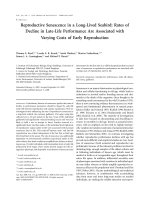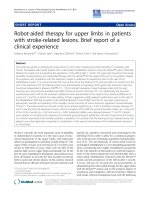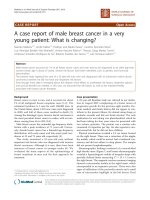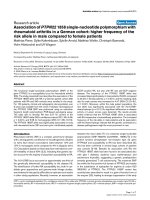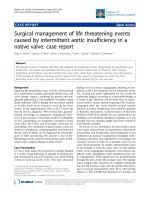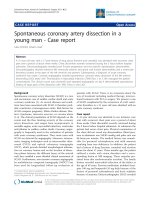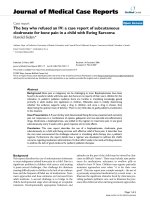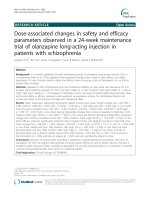Metachronous ovarian endometrioid carcinomas in a patient with a PTEN variant: Case report of incidentally detected Cowden syndrome
Bạn đang xem bản rút gọn của tài liệu. Xem và tải ngay bản đầy đủ của tài liệu tại đây (1.39 MB, 5 trang )
Matsubayashi et al. BMC Cancer
(2019) 19:1014
/>
CASE REPORT
Open Access
Metachronous ovarian endometrioid
carcinomas in a patient with a PTEN variant:
case report of incidentally detected
Cowden syndrome
Hiroyuki Matsubayashi1,2* , Satomi Higashigawa1, Yoshimi Kiyozumi1, Yasue Horiuchi1, Yasuyuki Hirashima3,
Nobuhiro Kado3, Masato Abe4, Takuma Ohishi4, Sumiko Ohnami5, Kenichi Urakami5 and Ken Yamaguchi5
Abstract
Background: Somatic PTEN mutation occurs in a proportion of ovarian endometrioid carcinomas. However, these
cancers have seldom been reported in diseases associated with germline PTEN variants, such as Cowden syndrome
(CS).
Case presentation: The present case was a 39-year-old woman with a left ovarian carcinoma who demonstrated a
germline splice variant of PTEN (c.1026 + 1G > T) following genome-wide whole exome sequencing of her germline
DNA. Histology of her resected tumor revealed endometrioid carcinoma of the same type as a right ovarian cancer
resected eight years previously. These tumors showed null immunostaining for PTEN. She was genetically
diagnosed with CS. Despite her clinical examinations had demonstrated several characteristic findings of CS,
including mammary fibroma, esophageal and skin papilloma, colonic hamartoma, uterine myoma, and lipoma, the
clinicians could not approach this diagnosis.
Conclusion: Ovarian endometrioid carcinoma is generally thought to develop from endometrial tissue menstruated
from the uterus and implanted on the ovary. To date, ovarian cancers have not been listed as CS-related cancers;
however, ovarian endometrioid cancer can have a potential association with CS in endometriosis cases.
Keywords: Ovarian, Endometrioid carcinoma, PTEN, Germline variant
Background
Pathogenic variants of germline PTEN result in autosomal dominant hereditary disease or PTEN hamartoma
tumor syndromes (PHTS), including Proteus syndrome
(PS), Proteus-like syndrome (PLS), Bannayan-RileyRuvalcaba syndrome (BRRS), and Cowden syndrome
(CS). CS is clinically diagnosed based on the major
criteria associated with three types of cancer (breast, thyroid, and endometrium) and macrocephaly, as well as by
minor criteria that include other benign thyroid lesions;
intellectual disability (IQ ≤75); intestinal hamartomatous
polyps; mammary fibrocystic disease; lipomas; fibromas;
genitourinary tumors and malformation; and uterine fibroids [1].
Ovarian cancer is not included in the above criteria, but
uterine endometrial carcinoma is included. Ovarian endometrioid carcinoma is thought to develop from endometrial tissue menstruated from the uterus and implanted on
the ovary [2]. We report a unique case of CS who had a
germline PTEN splice variant and subsequently developed
metachronous bilateral ovarian endometrioid carcinomas
without expressing the PTEN protein.
* Correspondence:
1
Division of Genetic Medicine Promotion, Shizuoka Cancer Center,
Nagaizumi, Suntogun, Shizuoka 411-8777, Japan
2
Division of Endoscopy, Shizuoka Cancer Center, 1007 Shimonagakubo,
Nagaizumi, Suntogun, Shizuoka, Japan
Full list of author information is available at the end of the article
Case presentation
The patient was a Japanese woman with a past history of
left ovarian endometrioid carcinoma (grade 2, FIGO stage
IC1) that had been resected by salpingo-oophorectomy,
© The Author(s). 2019 Open Access This article is distributed under the terms of the Creative Commons Attribution 4.0
International License ( which permits unrestricted use, distribution, and
reproduction in any medium, provided you give appropriate credit to the original author(s) and the source, provide a link to
the Creative Commons license, and indicate if changes were made. The Creative Commons Public Domain Dedication waiver
( applies to the data made available in this article, unless otherwise stated.
Matsubayashi et al. BMC Cancer
(2019) 19:1014
omentectomy and retroperitoneal lymph node biopsy (fertility sparing surgery) when she was 31 years old. She had
a history of multiple thyroid goiters (maximum 2 cm),
bilateral breast fibroma treated by surgical resection at age
15, endometriosis (at age 28) and myoma, and salpingitis
treated by peroral medications (at age 28). She was intellectual enough to evaluate her IQ over 75. While in her
30s, she sometimes complained of lower abdominal pain
and melena. A colonoscopy revealed colorectal polypoid
lesions that were histologically diagnosed by forceps
biopsy as hamartoma polyps and ectopic endometrial implants (Fig. 1a, b). An upper gastrointestinal endoscopy
screening demonstrated multiple esophageal papillomas
and glycogenic acanthosis (Fig. 1c). A gluteal subcutaneous lipoma, 55 mm in size, was detected by screening
magnetic resonance imaging (MRI). The patient’s mother
died of breast cancer in her 40s, and her father had a
pathology-confirmed cutaneous papilloma on his head
and neck. The patient had no smoking or drinking habits.
The patient had been undergoing surveillance for the
endometriosis by yearly pelvic image examinations, and a
right ovarian tumor was detected at age 39. Computed tomography (CT) demonstrated a heterogeneously enhanced
mass, 9 cm in size, while 18F-fluorodeoxyglucose-positron
emission tomography (FDG-PET) showed abnormal uptake
by the ovarian tumor (SUVmax: 8.33). She underwent abdominal total hysterectomy, right salpingo-oophorectomy,
pelvic lymphadenectomy and para-aortic lymphadenectomy.
Endometrioid carcinoma (grade 1, FIGO stage: IC2), partially
accompanied with components of squamous metaplasia and
low-grade adenofibroma, was detected in the resected ovary.
Immunostainings of the right-ovarian endometrial carcinoma
revealed high expression of estrogen receptor, PI3K, and Ki67 (labeling index approximately 40%), but TP53 showed no
overexpression, and PTEN, WT1, Napsin A, and HNF-1β
were not expressed (Fig. 2). Immunostainings of PI3K
showed diffuse expression, but PTEN was not expressed, as
also determined in the left ovarian tumor.
All resected lymph nodes were negative for cancer (0/
120). Her uterus specimen confirmed myomas and
endometriosis.
Upon full informed consent, the patient participated in
genetic research at the time of surgery. Peripheral blood
and a 4–5 mm3 area of fresh right-ovarian cancer tissue
were taken at surgery for whole exome sequencing
(WES) to compare germline DNA and cancer DNA
using a next-generation sequencer [3, 4]. An exome library, including 723 cancer-associated genes and 49
genes [3] responsible for hereditary cancer syndromes,
was prepared using the Ion AmpliSeq Exome RDY kit
(Thermo Fisher Scientific, Massachusetts, USA). Exome
sequencing of the right endometrioid carcinoma revealed a pathogenic mutation of hexose-6-phosphate dehydrogenase/glucose 1-dehydrogenase (H6PD), TFAP2D,
Page 2 of 5
Matsubayashi et al. BMC Cancer
(2019) 19:1014
(See figure on previous page.)
Fig. 1 Endoscopic findings. a An indigo carmine stained colonic
hamartomatous polyp, b Indigo carmine stained rectal polyps of
heterotopic endometriosis, c Screening by upper gastrointestinal
endoscopy demonstrated multiple esophageal papillomas and
glycogenic acanthosis
MYO7A, TGM1, SEMA6B, ZNF99, and SIGLEC1. Loss of
heterozygosity (LOH) in the 10q.23.3 (PTEN) locus was not
recognized by copy number variation analysis in this tumor
DNA. Her blood DNA demonstrated a splice-donor site
variant of PTEN (c.1026 + 1G > T) [5], that had been
reported to be causative of intellectual disability. This sequence was confirmed by the Sanger sequencing (Fig. 3).
No other germline mutation or incidental pathogenic finding was recognized.
Despite a number of characteristic findings in her
demographics, images and pathologies, the clinicians did
not approach the diagnosis of Cowden syndrome (CS)
until the detection of germline PTEN variant. At the
counseling, multiple (> 6) palmar small papules, buccal
papillomas, and macrocephaly (head circumference: 60
cm, > 97th percentile) were further recognized by the
physical examinations, fully meeting the clinical criteria
of CS. She received clinical surveillance of the organs
Page 3 of 5
associated with PHTS [1]. Her father also underwent
genetic test, but the variant of PTEN was not recognized.
Three years have passed since the last surgery. No recurrence has been detected.
Discussion and conclusions
An elevated risk of ovarian carcinoma has not been reported in cases with germline PTEN variants, although
an association of PTEN with uterine endometrial carcinoma is well known (standardized incidence rate: 42.9,
lifetime risk: 28.2%) [6]. However, ovarian endometrioid
carcinoma is thought to develop from endometrial tissue
menstruated in retrograde and implanted on the ovary
[2]. Somatic mutation of PTEN is recognized in 53% of
endometriosis cases [7], and LOH in the 10q.23.3 locus
occurs in a range from 25% [8] to 84% [7]. Moreover,
PTEN mutation is recognized in 20% [9, 10] of ovarian
endometrioid carcinomas and the LOH is 60 [10] to 64%
[8]; however, these values are much lower in other types
of ovarian carcinomas (2% mutation rate; 28% LOH)
[10]. These data suggest a specific association of PTEN
alterations and endometrioid-type ovarian cancer.
Ovarian endometrioid carcinoma has seldom been
reported in cases of Cowden syndrome (CS). The
current case demonstrated metachronous bilateral ovarian endometrioid carcinoma with an 8-year interval.
Fig. 2 Pathology of the right-ovarian tumor. a Hematoxylin and eosin (H&E) staining showing endometrioid carcinoma, grade 1 (× 40).
Immunostaining of the tumor showing diffuse expression of estrogen receptor (× 100)(b) and PI3K (× 100)(c). d Null expression of PTEN in the
tumor, contrasting with the positive expression in the interstitial cells and inflammatory cells (× 100)
Matsubayashi et al. BMC Cancer
(2019) 19:1014
Page 4 of 5
Fig. 3 A PTEN variant (c.1026 + 1G > T) confirmed by Sanger sequencing (an arrow indicating the variant)
Endometriosis, but not endometrioid carcinoma, was
recognized in the patient’s resected uterus; therefore, we
speculated that an independent carcinogenesis had occurred in the bilateral ovaries or that carcinoma cells
had exfoliated from the unilateral ovary and implanted
to the other side. The expression patterns of PI3K and
PTEN were the same; however, metastasis (from the left
to the right ovary) had not been anticipated since both
tumors contained low-grade components, which rarely
metastasize. Our case suggested a risk for non-uterine
endometrioid carcinoma in cases of CS, indicating that
all ectopic endometrioses are at risk and require careful
follow up or endoscopic resection of rectal endometriosis. Most recently, a case of CS was reported from
France, that carried a pathogenic PTEN variant
(c.388C > T) and developed an ovarian clear cell carcinoma showing loss of PTEN expression [11], like our
case. Ovarian clear cell carcinoma has several biological
characteristics similar to those of endometrioid carcinoma,
such as a pathogenesis through the ovarian endometriosis
and common somatic mutations [PIK3CA (15–60%),
ARID1A (30–57%), CTNNB1 (3–53%) and DNA mismatch
repair genes (4–13%)] [9, 12]. In addition to these
endometriosis-associated ovarian cancers, several cases of
embryonic tumors [13] and dysgerminoma [14] have also
reported in cases of CS with germline PTEN variants, however their pathological and genetic rationale is unclear.
These data give us a warning for the ovarian findings including endometriosis in cases of CS [15].
The patient had several characteristic CS findings that
satisfied one major criteria (macrocephaly) and five
minor criteria (multiple thyroid goiters, bilateral mammary fibromas, intestinal hamartomas, an uterine myoma, and a gluteal lipoma), so she could be clinically
diagnosed with CS [1]. Based on the retrospective
assessment using Cleveland Clinic PTEN Risk Calculator
( probability of
PTEN variant in this patient was estimated between 99.4
and 100%, even not including her histories of ovarian
endometrioid cancers. However, she had not been diagnosed until after the genetic test for several reasons: the
lack of a sense of inherited diseases in the doctor’s mind,
multi-department associations beyond each doctor’s expertise field, diagnostic criteria that were characteristic
but not really specific to CS, and an atypical CS cancer
type. The patient did not have any children, so familial
information was limited to her mother who had died of
breast cancer at her 40s. In this sense, clinical cancer
sequencing using next generation sequencing would potentially increase the possibility of incidentally detecting
inherited cancer syndromes with atypical findings or
relatively weak phenotypes.
Clinical sequencing sometimes reveals a novel variant
that needs determination of its pathogenicity. The
current splice donor site variant (c.1026 + 1G > T) is located at the intron 8 or C-terminal site of PTEN, and its
pathogenicity has been reported previously for characteristic PTEN intellectual disability [5]. To the best of
our knowledge, the current report is the first cancer case
associated with this PTEN variant (c.1026 + 1G > T), and
the cancer was negative for PTEN expression, as confirmed by the immunostaining antibody, clone 6H2.1,
that recognizes an epitope located at the C-terminal region. PHTS has a genotype–phenotype correlation and
includes a cancer-associated (CS and BRRS) and a noncancer associated (PS and PLS) [1] group. Some PTEN
variants only cause cancers but show no other criteria of
CS [4]. In this sense, the current pathogenic variant of
PTEN (c.1026 + 1G > T) appears to associate with a variety of characteristic CS findings.
Matsubayashi et al. BMC Cancer
(2019) 19:1014
We reported an incidentally detected case of CS in a patient who had carried a pathogenic variant of PTEN
(c.1026 + 1G > T) and developed bilateral ovarian endometrioid cancers without PTEN expression. Ovarian endometrioid carcinoma can be considered a CS-associated
cancer, and caution is needed for ovarian findings including endometriosis in cases of CS.
Availability of data and materials
The datasets used and/or analyzed in the current are
available from the corresponding author on reasonable
request.
Abbreviations
BRRS: Bannayan-Riley-Ruvalcaba syndrome; CS: Cowden syndrome;
CT: Computed tomography; FDG-PET: 18F-fluorodeoxyglucose-positron
emission tomography; LOH: Loss of heterozygosity; MRI: Magnetic resonance
imaging; PHTS: PTEN hamartoma tumor syndromes; PLS: Proteus-like
syndrome; PS: Proteus syndrome; WES: Whole exome sequencing
Acknowledgements
Not applicable.
Authors’ contributions
HM collected the data and wrote the manuscript, SH, YK, YH, and HM
participated genetic counseling and genetically managed the patient and
her family, YH and NK performed surgery and gynecological managements,
MA and TO managed pathological sampling and diagnosis, SO and KU
performed genetic analysis, and KY organized and approved this study. All
authors have read and approved the manuscript.
Funding
Not applicable.
Page 5 of 5
4.
5.
6.
7.
8.
9.
10.
11.
12.
13.
14.
15.
Uemura S, Matsubayashi H, Kiyozumi Y, et al. Pancreatic adenocarcinoma
with a germline PTEN p.Arg234Gln mutation. Familial Cancer. 2018;17:255–9.
Tatton-Brown K, Loveday C, Yost S, et al. Mutations in epigenetic regulation
genes are a major cause of overgrowth with intellectual disability. Am J
Hum Genet. 2017;100:725–36.
Tan MH, Mester JL, Ngeow J, et al. Lifetime cancer risks in individuals with
germline PTEN mutations. Clin Cancer Res. 2012;18:400–7.
Govatati S, Kodati VL, Deenadayal M, et al. Mutations in the PTEN tumor
gene and risk of endometriosis: a case-control study. Hum Reprod. 2014;29:
324–36.
Xu B, Hamada S, Kusuki I, et al. Possible involvement of loss of
heterozygosity in malignant transformation of ovarian endometriosis.
Gynecol Oncol. 2011;120:239–46.
Sato N, Tsunoda H, Nishida M, et al. Loss of heterozygosity on 10q23.3 and
mutation of the tumor suppressor gene PTEN in benign endometrial cyst of
the ovary: possible sequence progression from benign endometrial cyst to
endometrioid carcinoma and clear cell carcinoma of the ovary. Cancer Res.
2000;60:7052–6.
Kolasa IK, Rembiszewska A, Janiec-Jankowska A, et al. PTEN mutation,
expression and LOH at its locus in ovarian carcinomas. Relation to TP53, KRAS and BRCA1 mutations. Gynecol Oncol. 2006;103:692–7.
Yauy K, Imbert-Bouteille M, Bubien V, et al. Ovarian clear cell carcinoma in
Cowden syndrome. J Natl Compr Cancer Netw. 2019;17:7–11.
Fadare O, Parkash V. Pathology of Endometrioid and clear cell carcinoma of
the ovary. Surg Pathol Clin. 2019;12:529–64.
Bubien V, Bonnet F, Brouste V, et al. High cumulative risks of cancer in
patients with PTEN hamartoma tumour syndrome. J Med Genet. 2013;50:
255–63.
Cho MY, Kim HS, Eng C, et al. First report of ovarian dysgerminoma in
Cowden syndrome with germline PTEN mutation and PTEN-related 10q loss
of tumor heterozygosity. Am J Surg Pathol. 2008;32:1258–64.
Papageorgiou T, Stratakis CA. Ovarian tumors associated with multiple
endocrine neoplasias and related syndromes (carney complex, PeutzJeghers syndrome, von Hippel-Lindau disease, Cowden's disease). Int J
Gynecol Cancer. 2002;12:337–47.
Publisher’s Note
Availability of data and materials
All data generated or analyzed during this study are included in this article.
Ethics approval and consent to participate
Institutional Review Board of Shizuoka Cancer Center ethically approved this
study, and the written informed consent was obtained from the patient.
Consent for publication
Written informed consent was obtained from the patient for publication of
this case report and any accompanying images.
Competing interests
The authors declare that they have no competing interests.
Author details
1
Division of Genetic Medicine Promotion, Shizuoka Cancer Center,
Nagaizumi, Suntogun, Shizuoka 411-8777, Japan. 2Division of Endoscopy,
Shizuoka Cancer Center, 1007 Shimonagakubo, Nagaizumi, Suntogun,
Shizuoka, Japan. 3Division of Gynecology Shizuoka Cancer Center, Nagaizumi,
Suntogun, Shizuoka 411-8777, Japan. 4Division of Pathology Shizuoka Cancer
Center, Nagaizumi, Suntogun, Shizuoka 411-8777, Japan. 5Research Institution
of Shizuoka Cancer Center, Nagaizumi, Suntogun, Shizuoka 411-8777, Japan.
Received: 12 June 2019 Accepted: 17 October 2019
References
1. Eng C. PTEN Hamartoma Tumor Syndrome (PHTS): GeneReviews [Internet]
updated in 2016.
2. Kurman RJ, Shih IM. The origin and pathogenesis of epithelial ovarian
cancer: a proposed unifying theory. Am J Surg Pathol. 2010;34:433–43.
3. Urakami K, Shimoda Y, Ohshima K, et al. Next generation sequencing
approach for detecting 491 fusion genes from human cancer. Biomed Res.
2016;37:51–62.
Springer Nature remains neutral with regard to jurisdictional claims in
published maps and institutional affiliations.
